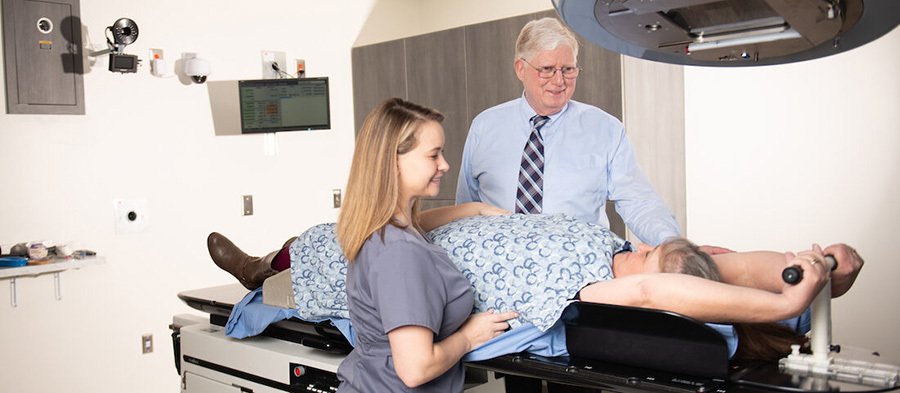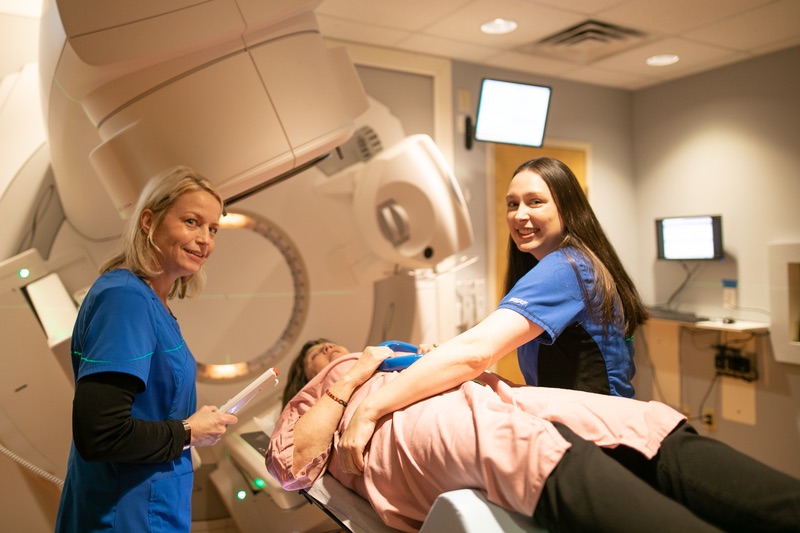
Treatment options for people with endometrial cancer are surgery, radiation therapy, chemotherapy, and hormone therapy. You may receive more than one type of treatment.
Most women will have surgery to remove the cancer first, followed by other treatments. If the oncologist feels it would be better to shrink the tumor before removing it, then other treatments may be given first. This is called neoadjuvant cancer treatment.
Radiation therapy is a treatment that uses high-energy x-rays or other types of radiation to kill cancer cells or prevent them from growing. It may be used before or after surgery. For women who can’t have surgery for other medical reasons, radiation therapy may be used instead to destroy cancer cells in the uterus. Women with cancer that invades tissue beyond the uterus may have radiation therapy and chemotherapy.
Both external beam radiation therapy and brachytherapy are used during the course of a patient’s endometrial cancer treatment. If you or someone you love has been diagnosed with endometrial cancer, you have options for where to receive radiation therapy. Find a location that’s close to you in the Atlanta area.
External radiation therapy uses a large machine that directs radiation at your pelvis or other areas with cancer. The treatment is usually given in a hospital or clinic. You may receive external radiation five days a week for a few weeks. Each session takes only a few minutes. IMRT, Intensity Modulated Radiation Therapy, is a type of external beam radiation therapy that is commonly used to treat endometrial cancer. It precisely targets where the cancerous cells are, or were, located while avoiding other vital organs nearby such as the bladder and rectum.
Internal radiation therapy (also called brachytherapy) involves placing a narrow cylinder loaded with a radioactive substance inside your vagina. This common method of brachytherapy may be repeated two or more times over several weeks. Once the radioactive substance is removed, no radioactivity is left in the body. With internal radiation therapy the treatment gets closer to the area where the cancer is located while releasing the radiation to kill cancer cells.
Sometimes both types of radiation therapy are used, depending on the location and amount of cancer present.

Surgery of some type is almost always a part of endometrial cancer treatment. You and your surgeon, who is also typically your gynecologic oncologist, can talk about which surgical option is right for you. The following surgical procedures may be used:
Total hysterectomy: Surgery to remove the uterus and cervix. If the uterus and cervix are taken out through the vagina, the operation is called a vaginal hysterectomy. If a large incision (cut) in the abdomen is made to take out the uterus and cervix, the operation is called a total abdominal hysterectomy. If a small incision is made in the abdomen using a laparoscope, the operation is called a total laparoscopic hysterectomy.
Bilateral salpingo-oophorectomy: Surgery to remove the two ovaries and both fallopian tubes.
Radical hysterectomy: Surgery to remove the uterus, cervix, and part of the vagina. The ovaries, fallopian tubes, or nearby lymph nodes may also be removed.
Chemotherapy uses drugs to kill cancer cells. It may be used after surgery to treat endometrial cancer that has an increased risk of returning after treatment. For example, endometrial cancer that is a high grade or is Stage II, III, or IV may be more likely to return. Also, chemotherapy may be given to women whose endometrial cancer can’t be completely removed by surgery. For advanced cancer, it may be used alone or with radiation therapy.
The growth of some endometrial tumors is caused by hormones like estrogen and progesterone. Hormone therapy is a cancer treatment that removes these hormones or blocks their action and stops cancer cells from growing. If lab tests show that the tumor in your uterus has hormone receptors, then hormone therapy may be an option.
Hormone therapy may be used for women with advanced endometrial cancer. Some women with Stage I endometrial cancer who want to get pregnant choose hormone therapy instead of surgery. The most common drug used for hormone therapy is progesterone tablets.
Targeted therapy is a type of treatment that uses drugs or other substances to identify and attack specific cancer cells. Targeted therapies usually cause less harm to normal cells than chemotherapy or radiation therapy does. Monoclonal antibodies, mTOR inhibitors, and signal transduction inhibitors are three types of targeted therapy used to treat endometrial cancer.
Immunotherapy, also called biologic therapy, is treatment with drugs that help a person’s own immune system better recognize and kill cancer cells. Currently, there are two FDA-approved immunotherapies for the treatment of endometrial cancer.
If you have received a uterine cancer diagnosis, there are a lot of choices for you to discuss with your cancer care team. Several people will typically be involved: your gynecologic oncologist, a radiation oncologist, a medical oncologist (if needed) along with the radiation therapists, nurses and other caring staff who will help you through this process.
Because endometrial cancer can be found early in most patients, the long-term survival rate (5-year survival rate) for localized (early-stage) cancer is at 95%! Don’t delay. Request an appointment with your gynecologist if you suspect there’s something wrong.
And if you need cancer treatment, remember you can choose where you receive every aspect of your care.
Quickly and efficiently build the materials you need to support your inbound marketing strategy. Drag and drop building blocks including testimonials, forms, calls-to-action, and more.